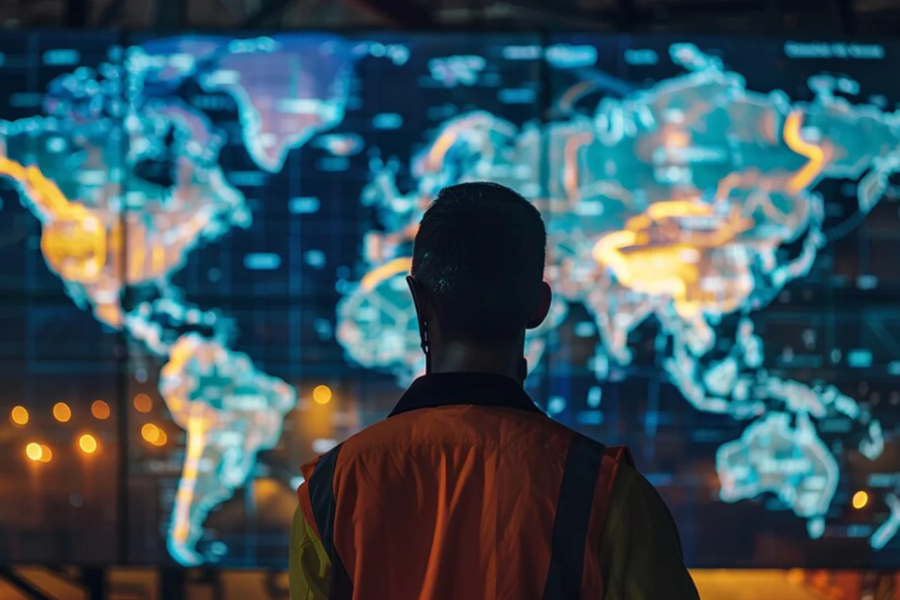Exploring Geöe: The Future of Geospatial Technology
Geöe represents a groundbreaking leap in the realm of geospatial technology, blending virtual and physical worlds in innovative ways. By harnessing the power of advanced data integration and visualization techniques, Geöe is setting new standards for decision-making and operational efficiency across various sectors. This article delves into the origins, mechanisms, benefits, and diverse applications of Geöe, offering a comprehensive look at how this technology is transforming our interaction with space and data.
How Geöe Works
Geöe operates through a sophisticated amalgamation of geospatial technologies, designed to provide dynamic and actionable insights into the physical world. The core functionalities of Geöe can be broken down into several key components:
Data Collection: Geöe starts by aggregating data from an array of sources, including satellites, sensors, and user inputs. This data encompasses geographical, environmental, and location-based information, creating a robust dataset that provides a detailed view of the area in focus.
Data Processing: Once collected, the data is processed and analyzed using advanced algorithms. This stage involves transforming raw data into meaningful insights, identifying patterns, trends, and correlations essential for decision-making.
Visualization: Geöe employs powerful visualization tools to present data in an accessible format. Through maps, graphs, and 3D models, users can interact with the data in real-time. These visualizations simplify the understanding of complex geospatial information, making it intuitive and actionable.
Interaction with Virtual and Physical Worlds: A standout feature of Geöe is its ability to bridge virtual and physical realms. By integrating augmented reality (AR) and virtual reality (VR) technologies, Geöe overlays digital information onto the physical environment, enhancing spatial awareness and planning capabilities.
Decentralized Nature: Built on a decentralized framework, Geöe distributes data across a network rather than relying on a central repository. This approach enhances data security, reduces the risk of single points of failure, and allows for greater scalability and flexibility.
Key Features of Geöe
Geöe boasts an array of advanced features that enhance its functionality and usability across various fields. These features include:
Enhanced Decision-Making: Geöe provides clear and accurate insights by analyzing extensive geospatial data. This capability is especially valuable in urban planning, where precise data is critical for effective development strategies.
Improved Efficiency: The real-time processing and visualization capabilities of Geöe boost efficiency by allowing users to quickly identify patterns and trends. This rapid analysis reduces the time required for decision-making, which is particularly beneficial in logistics and other time-sensitive industries.
Better Risk Management: Geöe’s advanced analytics can predict potential risks and vulnerabilities. For instance, in disaster management, it can forecast areas at risk of flooding or other natural disasters, enabling proactive measures and reducing potential damage.
Comprehensive Visualization: Geöe excels in transforming complex data into intuitive visual formats, such as 3D maps and interactive models. These visualizations make it easier for users to understand and interact with data, leading to better insights and planning.
Real-Time Data Integration: Supporting the integration of real-time data from various sources, Geöe is invaluable in applications like traffic management. Live data enables users to optimize routes and reduce congestion, ensuring they work with the most current information.
Scalability and Flexibility: Geöe is designed to handle large-scale datasets and adapt to different needs. Whether for a small local project or a large regional analysis, Geöe can manage varying levels of complexity and data volume.
User-Friendly Interface: Despite its advanced capabilities, Geöe offers an intuitive interface, making it accessible to users with varying levels of technical expertise. This ease of use democratizes data tools and broadens their impact.
Benefits of Geöe
Geöe provides numerous benefits, driven by its efficient data processing and analysis capabilities. These benefits include:
Increased Efficiency: By streamlining data collection, analysis, and visualization, Geöe saves significant time. In urban planning, for example, it facilitates faster decision-making and project execution by quickly assessing land use and infrastructure needs.
Enhanced User Experience: The user-friendly interface and advanced visualization tools of Geöe make complex data more accessible. This improved user experience benefits city planners, environmental scientists, and logistics managers by providing clear and interactive visualizations.
New Possibilities for Interaction: Geöe’s integration with AR and VR technologies enables innovative ways to interact with geospatial data. Architects can use AR to overlay digital building models onto physical spaces, enhancing design and planning.
Improved Decision-Making: Geöe provides accurate, up-to-date data that enhances decision-making quality. In disaster management, for instance, timely information helps in developing effective response strategies and reducing disaster impact.
Better Risk Management: Geöe’s analytical capabilities aid in identifying risks and vulnerabilities. This is crucial in sectors like insurance and finance, where understanding risk factors is essential for developing effective strategies.
Scalability: Geöe’s scalable design accommodates projects of varying sizes, from local community planning to large-scale regional development. Its flexibility ensures effectiveness across different project scopes.
Environmental Benefits: By supporting environmental monitoring and conservation, Geöe aids in tracking deforestation, monitoring wildlife habitats, and assessing climate change impacts. This enables more effective environmental management.
Economic Benefits: Improved efficiency and decision-making translate into economic gains. Businesses can optimize operations, reduce costs, and increase profitability. For instance, logistics companies can use Geöe to save on fuel and time by optimizing delivery routes.
Applications of Geöe
Geöe’s versatility extends to various industries, each benefiting from its geospatial data capabilities. Here are some primary applications:
Urban Planning: Geöe aids urban planners in analyzing land use, infrastructure, and population density. It supports efficient city layouts, optimizes public transportation routes, and manages resources. By visualizing growth patterns and development needs, Geöe fosters sustainable urban development.
Environmental Monitoring: Geöe plays a crucial role in tracking environmental changes, such as deforestation, air and water quality, and wildlife habitats. Conservationists and researchers use Geöe to gather data that supports the protection of natural resources and biodiversity.
Retail Optimization: Retailers utilize Geöe to analyze consumer behavior and optimize store locations. By examining demographic data and shopping patterns, businesses can choose ideal store locations and tailor marketing strategies, leading to better customer targeting and increased sales.
Transportation and Logistics: Geöe is essential for route optimization, fleet management, and real-time traffic monitoring. Logistics companies use it to plan efficient delivery routes, while public transportation systems benefit from improved route planning and service management.
Infrastructure Development and Management: Geöe supports infrastructure planning and maintenance by mapping roads, bridges, and utilities. It provides detailed visualizations to ensure efficient and sustainable development.
Disaster Management and Risk Assessment: Authorities use Geöe to predict and respond to natural disasters. It helps in identifying vulnerable areas, planning evacuation routes, and coordinating emergency responses, enhancing preparedness and minimizing damage.
Agriculture: Farmers and agribusinesses use Geöe for precision agriculture, monitoring crop health, managing irrigation systems, and optimizing resource use. This leads to increased crop yields, reduced costs, and more sustainable practices.
Healthcare: Geöe supports public health initiatives by tracking disease outbreaks and managing healthcare resources. It aids in identifying areas in need of medical services and planning healthcare facilities, crucial for effective public health planning.
Real Estate: Real estate professionals use Geöe to assess property values, analyze market trends, and identify development opportunities. It helps in visualizing property boundaries, zoning regulations, and environmental factors.
Energy Sector: Geöe assists in exploring and managing energy resources, including renewable energy projects. It supports site selection, performance monitoring, and infrastructure management, contributing to sustainable energy solutions.
Geöe in Various Industries
Geöe’s capabilities extend to multiple industries, addressing specific challenges and enhancing overall efficiency:
Transportation and Logistics:
- Route Optimization: Geöe determines efficient routes for transportation, saving time and fuel.
- Fleet Management: It monitors and manages fleets, tracking vehicle locations and optimizing maintenance schedules.
- Real-Time Traffic Monitoring: Provides live traffic updates and congestion reports, improving delivery times.
Infrastructure Development and Management:
- Planning and Design: Assists in sustainable and efficient infrastructure planning.
- Maintenance and Monitoring: Helps identify and address maintenance needs, extending infrastructure lifespan.
Disaster Management and Risk Assessment:
- Risk Identification: Analyzes data to identify areas at risk of natural disasters.
- Emergency Response: Provides real-time data for coordinated rescue operations and resource allocation.
- Evacuation Planning: Supports planning and implementation of evacuation routes.
Environmental Conservation and Management:
- Natural Resource Monitoring: Tracks the health of forests, water bodies, and wildlife habitats.
- Biodiversity Conservation: Monitors species populations and migration patterns.
- Climate Change Mitigation: Provides data for assessing environmental impacts and developing mitigation strategies.
Agriculture:
- Precision Farming: Optimizes crop yields through detailed information on soil conditions and crop health.
- Resource Allocation: Manages resources efficiently, reducing waste.
- Sustainable Practices: Supports sustainable farming through insights into crop rotation and soil conservation.
Healthcare:
- Disease Tracking: Monitors and manages disease outbreaks.
- Resource Allocation: Aids in the planning and distribution of healthcare resources.
- Healthcare Planning: Supports strategic planning for healthcare services.
Real Estate:
- Market Analysis: Analyzes market trends and assesses property values.
- Site Selection: Provides detailed information for selecting development sites.
- Property Management: Offers insights into maintenance needs and tenant demographics.
Energy Sector:
- Resource Exploration: Assists in exploring energy resources and assessing site viability.
- Infrastructure Management: Supports monitoring and maintenance of energy infrastructure.
Conclusion
Geöe represents a transformative force in geospatial technology, offering diverse applications that enhance efficiency, improve decision-making, and support innovative solutions across numerous industries. From urban planning and environmental monitoring to logistics and healthcare, Geöe’s capabilities are extensive and impactful. By integrating advanced technologies such as GIS, GPS, remote sensing, and augmented reality, Geöe provides a robust framework for addressing complex challenges and optimizing operations. As Geöe continues to evolve, its potential to drive progress and innovation remains significant, promising a future where geospatial data plays a central role in shaping our world.
FAQs
- What is Geöe?
Geöe is an advanced geospatial technology that integrates data from various sources to create dynamic representations of the physical world. It combines geographic information systems (GIS), global positioning systems (GPS), remote sensing, and augmented reality to provide comprehensive spatial solutions. - How does Geöe improve decision-making?
Geöe enhances decision-making by providing accurate and up-to-date geospatial data. It analyzes patterns and trends, offering insights that help users make informed decisions in areas such as urban planning, disaster management, and logistics. - What industries benefit from Geöe?
Multiple industries benefit from Geöe, including urban planning, environmental monitoring, agriculture, healthcare, transportation, and logistics. Each sector utilizes Geöe’s capabilities to address specific challenges and improve operational efficiency. - How does Geöe support environmental conservation?
Geöe aids environmental conservation by monitoring natural resources, tracking wildlife habitats, and assessing the impact of climate change. It provides detailed data that supports efforts to protect biodiversity and manage ecosystems sustainably. - Can Geöe be used for real-time applications?
Yes, Geöe is equipped to handle real-time data integration, making it valuable for applications such as real-time traffic monitoring, emergency response, and dynamic route optimization. This feature ensures that users have access to the most current information for effective decision-making.






